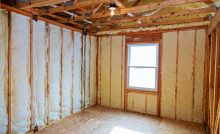A vented attic where insulation is placed on an air sealed attic floor is one of the most underappreciated building assemblies that we have in the history of building science.
Not enough ventilation in attic sheetrock cracks.
However if your attic has blocked soffit vents and is not well sealed from the rest of the house attic fans will suck cool conditioned air up out of the house and into the attic.
Additionally drywall cracks are often found where two pieces of drywall are butted together.
Attic fan ventilation attic fans are intended to cool hot attics by drawing in cooler outside air from attic vents soffit and gable and pushing hot air to the outside.
The drywall in my house separates from the ceiling and opens a gap of a quarter inch in the winter.
This article describes the common causes of all types of cracks that appear in drywall or gypsum board or plasterboard walls ceilings in building interiors.
But in homes that do not have proper attic insulation or ventilation heat tends to migrate.
These cracks usually run either horizontal or vertical at the drywall seams.
Generally heat rises and cool air falls.
Drywall cracks in ceilings or walls.
Poor attic ventilation creating quite the crackup los angeles times.
This is particularly common in cathedral vaulted ceilings with low profile rafters or joists that do not provide enough ventilation space above the.
Attic ventilation works on the principle that heated air naturally rises primarily utilizing two types of vents.
Ceiling cracks running diagonally across ceiling.
So much information has been devoted to the subject of roof venting that it s easy to become confused and to lose focus.
Attic ventilation in the summer.
Another common place to see these cracks is where two pieces of drywall come together.
Homes with vaulted ceilings may develop these cracks in the higher areas as well.
So i ll start by saying something that might sound controversial but really isn t.
For instance in some places like las vegas the sun tends to set on the roof causing the attic to be warm.
A crack a 16th of an inch or larger that runs at a diagonal angle through a sheet s of drywall requires a lot of force to create this crack.
Hot air fills the attic and raises the temperature.
This type of crack generally would be considered a red flag depending on width length and location.
Illustrations show where cracks are most likely to appear explain why and suggest both repair approaches to drywall cracks and how to prevent cracking in plasterboard or gypsum board.
Water leaking from a window or the roof or even a leaky attic water line can run down inside a wall s framing and saturate the drywall which then softens and deteriorates creating a crack.




























